The CX Report gathers trends on how business happens in the computational era by examining the tech stacks for marketing and products in the context of digital transformation.
“Employee experience is what makes your CX human, Publicis Sapient Chief Experience Officer John Maeda says in a new annual report.”
—THE WALL STREET JOURNAL
Watch The 2020 CX Report In 13½ Minutes
The 2020 and 2021 CX Reports have been taken down due to concern expressed by an organization representing an artist who passed away that the artwork I commissioned by Tony Ruth allegedly violated a copyright. Sorry!
- The Internet has become exactly what Bowie predicted in 1999.
- Computational thinking is the new systems thinking for business.
- Digital marketing loops spin way faster than digital product loops can spin.
- The 4th Industrial Revolution has invisible smoke stacks everywhere.
- Silicon Valley is people and not just robots. We tire. Machines don’t.
- Nobody’s in charge of customer experience because everyone is.
- Your Employee Experience (EX) is what makes your CX human. Literally.
- What’s experience? It’s a try-out, an experiment, and it can be perilous.
- If we all speak machine, then we can all avoid Big Tech’s blunders.
- Computational experiences are made by those who know how to speak machine.
If your customer experience feels like your org chart, that means you’re successfully running at scale. As a business (and as a human), the more important thing is to consider the implications of “the other CX”: Computational Experiences. They’re powered by Moore’s Law, they’re made by the few who know how to speak machine, and as humanity accelerates towards a “Kardashev 5” scale of digital transformation we should be both excited and terrified.
—John Maeda
2020 CX Report
Sponsored by The Earth
Computational Experiences Are Made By Those Who Know How To Speak Machine
👋🏽I am so glad you’re interested in the new CX Report. It’s made to be consumed on video, but I’ve included a PDF towards the bottom of this page. Please keep in mind that the PDF is not something easy to read — because I made this for YouTube instead of for PowerPointers. Because that’s the way folks do it these days as “video first.” Well, they’re on TikTok or Twitch I know, but I can’t dance or play videogames so you’ll have to YouTube with me.
- What kind of tooling differentiates the marketing tech stack and the product tech stack?
- How do you speak machine? And how does that change product development?
- Tech companies excel at Light, Ethical, Accessible, and Dataful experiences, or “LEAD.”
- Why do we need to consider Society Centered Design and Responsible Innovation today?
- Is the speed of digital transformation correlated with gender pay gap imbalances?
On Distributed Work and Remote Work
The March 2020 pre-release Appendix to the CX Report covering Distributed Work versus Remote Work is available here.
- Remote work isn’t the same as distributed work.
- Placemaking forms the grounds for work-making.
- Ch-ch-change is always an emotional journey.
- Collaboration is better than just cooperation.

Silicon Valley is people and not just robots. We tire. Machines don’t.
—John Maeda, Bloomberg Technology May 8, 2020
#cxreport20 Responses via CX Mailing List and Beyond
1) Computational thinking is an emergent property of systems thinking that’s been recast for this new era, 2) CX is a function of EX (Employee Experience), or CX = f (EX). *
—Ijeoma Azodo, M.D.
John Maeda uses the Kardashev Scale to represent the evolution of business in the digital world. This opens the possibility for greater scale or greater inequality.
—Jose Coronado, VP Design Operations
LEADという4つの視点からの企業評価。個人的にはEのEthicalとAのAccessibleであることが一番重要。
—Miho Tomiyama, Experience Designer
1) Org structure in large companies drives CX, 2) In big orgs people only touch pieces without ever seeing the big picture or being incentivized to do anything about it, 3) CDP promises to solve some of this and it’s still early in the hype cycle.
—Jeremy Finch, Proprietor
1) ただの体験でなく “Computationalな体験” を理解する必要がある。 2) CXはスピードや学習だけでなく倫理性や公平性(L. E. A. D)も含む。3) コンピューターと会話してカスタマーの声を聞く時代になる。
—@jimataro (in Japanese), Strategist
2020 CX Report Summary

Computational thinking is the new systems thinking for business.
—John Maeda, CNN Quest Means Business June 26, 2019
In 2020, This Is Where We’re At …

Our customer experience looks like our org chart! Even down to our departments and roles. How do we fix this?
—every successful Fortune 1000 company
The possibility for unintended consequences at a Kardashev scale greater or equal to three is high. And it can happen at a level of complexity that we won’t be able to easily fathom.
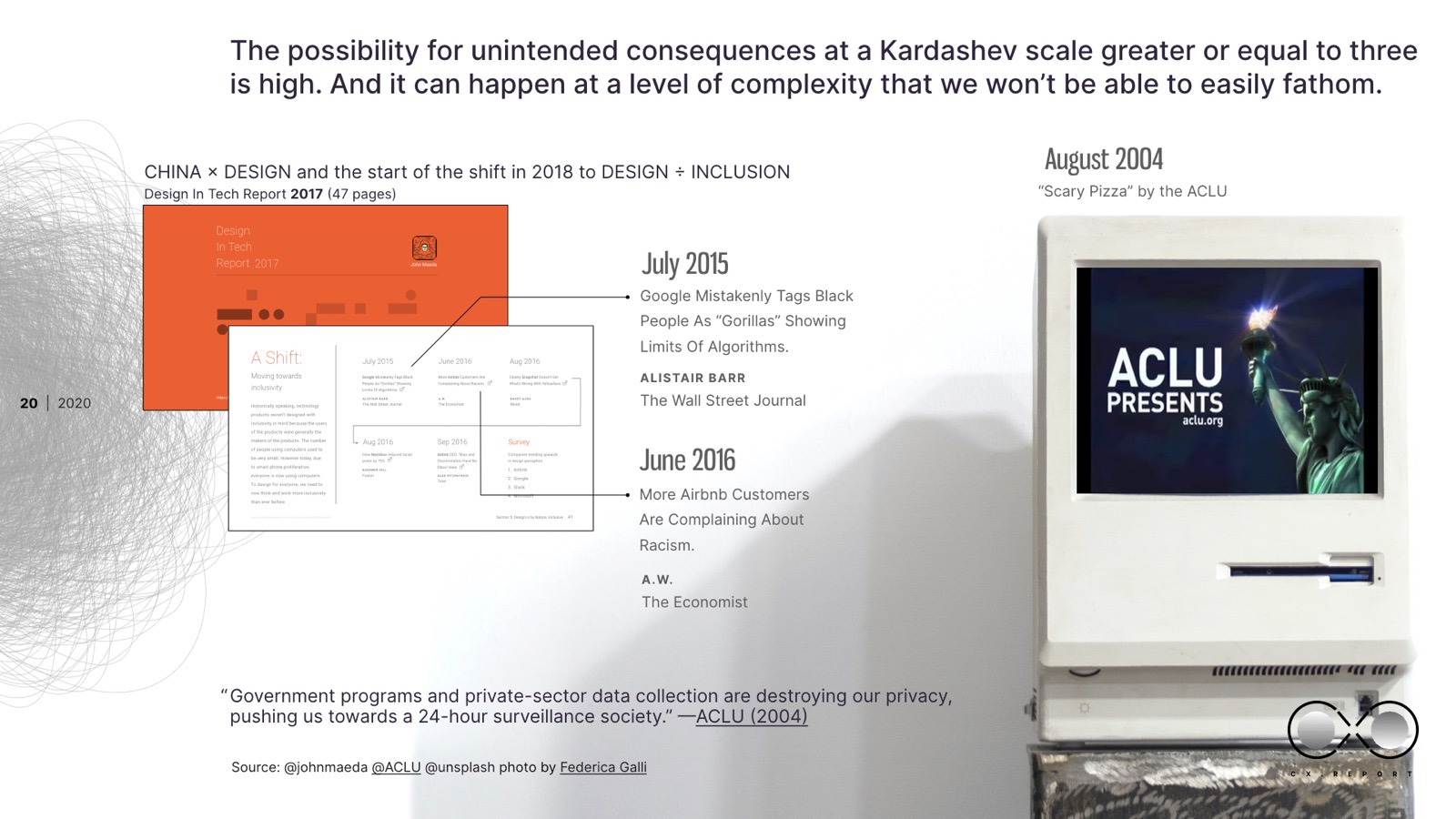
“Government programs and private-sector data collection are destroying our privacy, pushing us towards a 24-hour surveillance society.” —ACLU (2004)
For that reason, it’s important to know how to speak machine. Computation according to How To Speak Machine can be learned in 6 parts. It takes inspiration from Bowie by describing it as an alien-like material.

The 4th Industrial Revolution has invisible smoke stacks everywhere.
—John Maeda, How To Speak Machine
Blue Pill or Red Pill?
The reality of how digital technology intersects with society is profound. By learning how to speak machine, and how to speak human, you get to transform this new, alien world.
Are you comfortable with Kardashev 1, 2, 3? Or are you trying to get to Kardashev 3, 4, 5 — and feel inexplicably uncomfortable?

Blue Pill World (Kardashev 1, 2, 3)
You’re somewhere between Kardashev 1 and Karadashev 3 in your digital transformation journey.
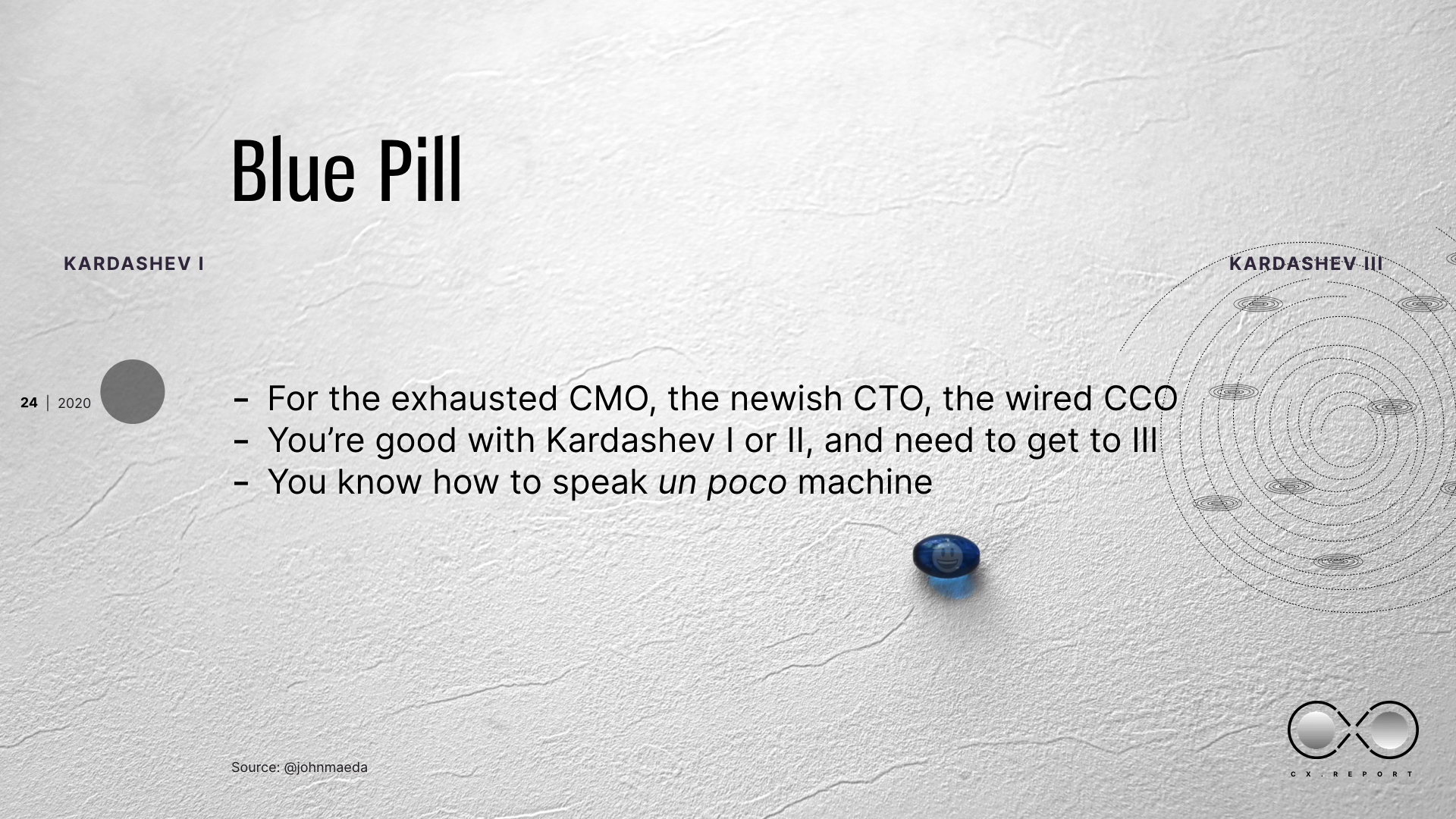
—You’re good with Kardashev 1 or 2, and need to get to 3
—You know how to speak un poco machine

Traditional CX refers to a “customer experience,” but you only become a customer after your purchase something. But CX usually refers to the entire experience.

“If you were to pick the main accountable owner(s) of ‘Customer Experience’ in your organization, which would it be? Choose as many as you like.”
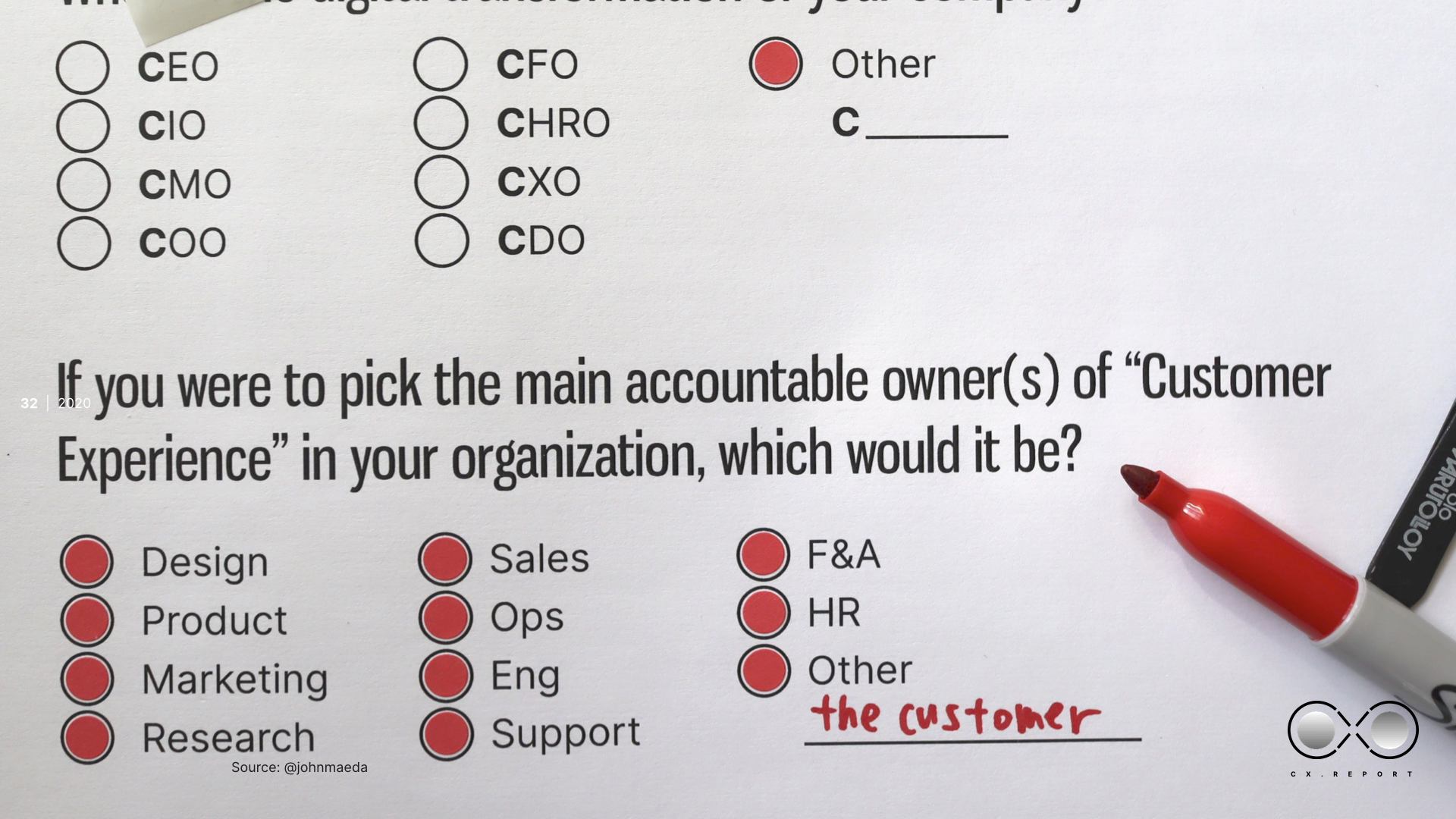

From the 2020 CX Report Survey (938 cleaned samples with 20% self described as product or biz owner, 71% self-described as design or research, and 9% self-described as eng or tech). Results are displayed proportionately, and arranged as to reduce bias towards the Designer/Researcher bias to the survey.
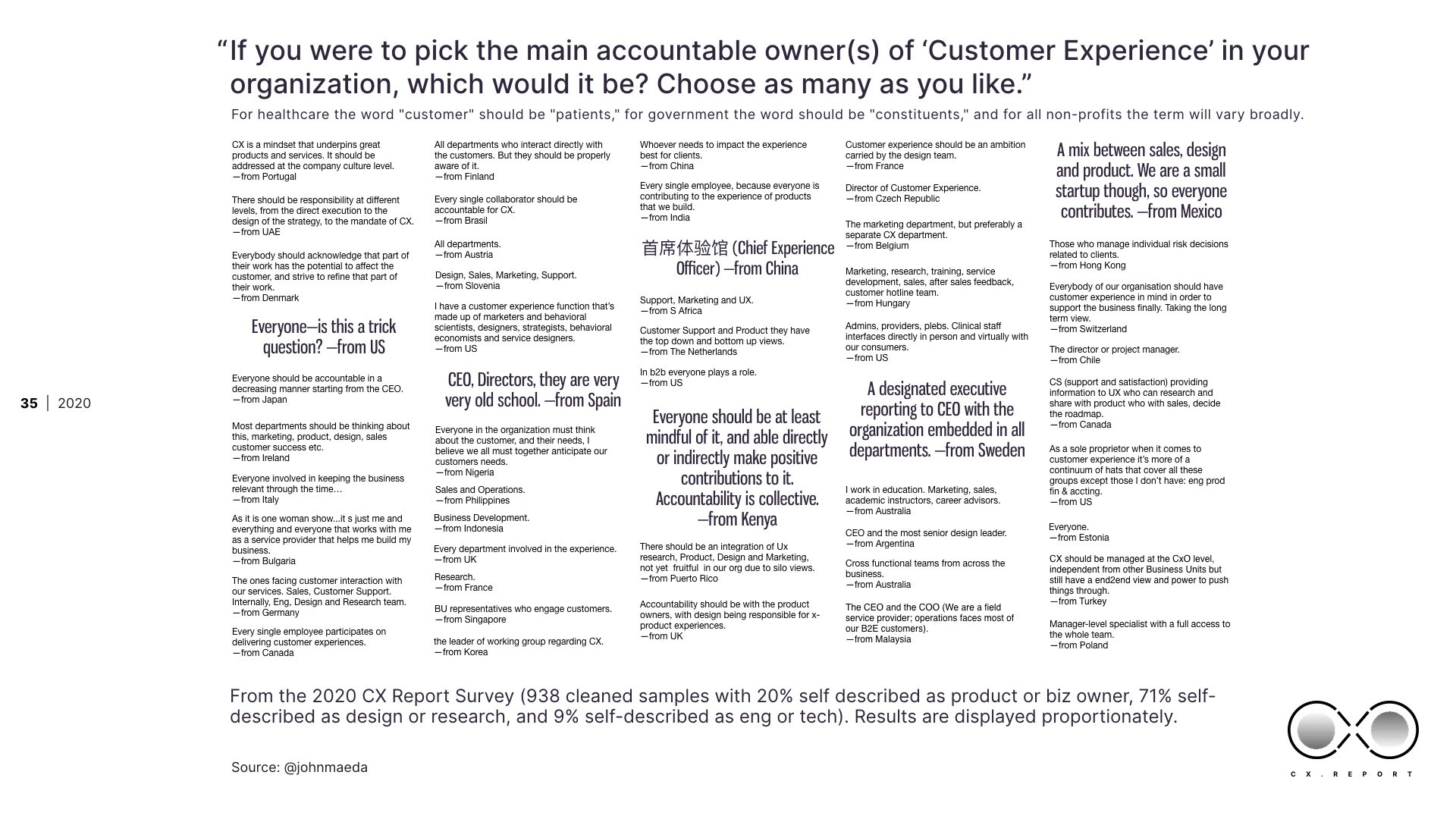
From the 2020 CX Report Survey (938 cleaned samples with 20% self described as product or biz owner, 71% self-described as design or research, and 9% self-described as eng or tech). Results are displayed proportionately. Open survey responses showed that there’s an interminable debate around who owns CX.
If you only see one solution to a problem, then you don’t really understand the problem.


- Nobody’s in charge of customer experience because everyone is.
- Computational thinking is the new systems thinking for business.
- All modern experiences are made with computation in some form.
- What’s experience? It’s a try-out, an experiment, and it can be perilous.
- The 4th Industrial Revolution has invisible smoke stacks everywhere.
- The cloud connects us all together in an infinite loop of engagement.
- If we all understand the cloud better, then we’ll avoid Big Tech’s blunders.
Your Employee Experience (EX) is what makes your CX human. Literally.
—John Maeda, 2020 CX Report Red Pill Section
Red Pill World (Kardashev 3, 4, 5)
You’re somewhere between Kardashev 3 and Karadashev 5 in your digital transformation journey. Kardashev5V makes you a little nervous.

—You’re shooting for Kardashev 3, 4, 5
—You know how to speak machine
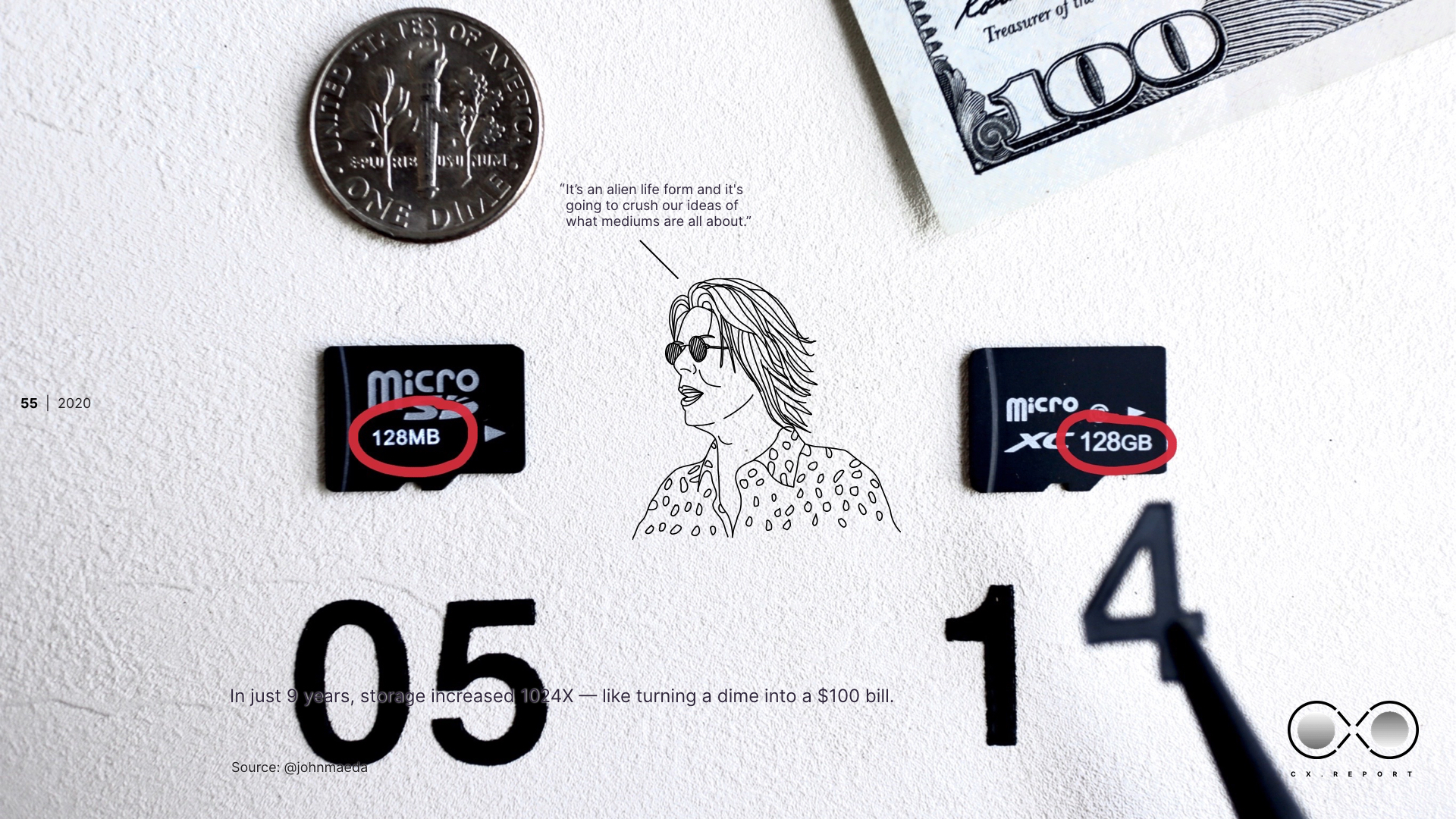

The underlying advantage of the leaner, faster, meaner production treadmill is the possibility to acquire tremendous amounts of insights on users at scale.
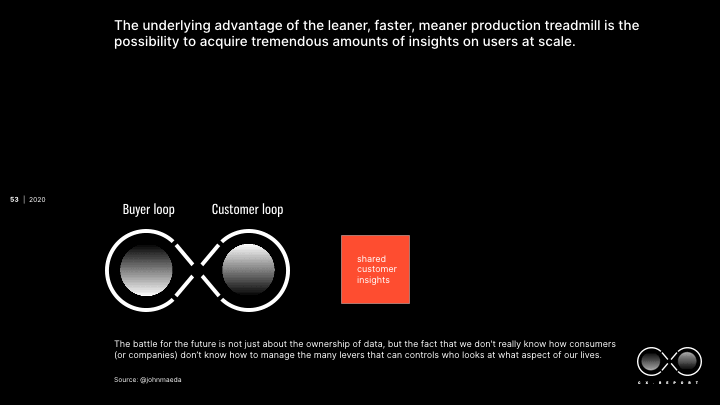
The battle for the future is not just about the ownership of data, but the fact that we don’t really know how consumers (or companies) don’t know how to manage the many levers that can controls who looks at what aspect of our lives.
As the late Bill Moggridge (1943-2012) said about the one design principle that truly matters: “… it’s probably about starting with the people.”
“The hallmark of a well-run development engine is a development cadence that is brisk in bringing new products to market without burning out its builders.”
—Megan Quinn

To bring back the loop notation I introduced in the report of a rotating feedback loop. It’s useful to consider how it’s a notation for “change” and self-improvement. John W. Gardner called it “self-renewal.”

Making change happen requires energy. When a business or organization is already running super lean, there’s not enough discretionary resources available to initiate or enact change. Old ways work fine. So change doesn’t happen.
The older generation will be in power proportionately longer than what past generations have felt because the “population pyramid” will become the “population rectangle.”

The neatly ordered organizational hierarchy we were all accustomed to has become disrupted by the flattening effect of social media. With new modes of communication have also come new expectations for responsiveness.
This is a hypothesis I have about digital transformation: Could the reason why it’s taking so long is because of the systemic gender pay gap? I’m curious to know if there’s data out there.*
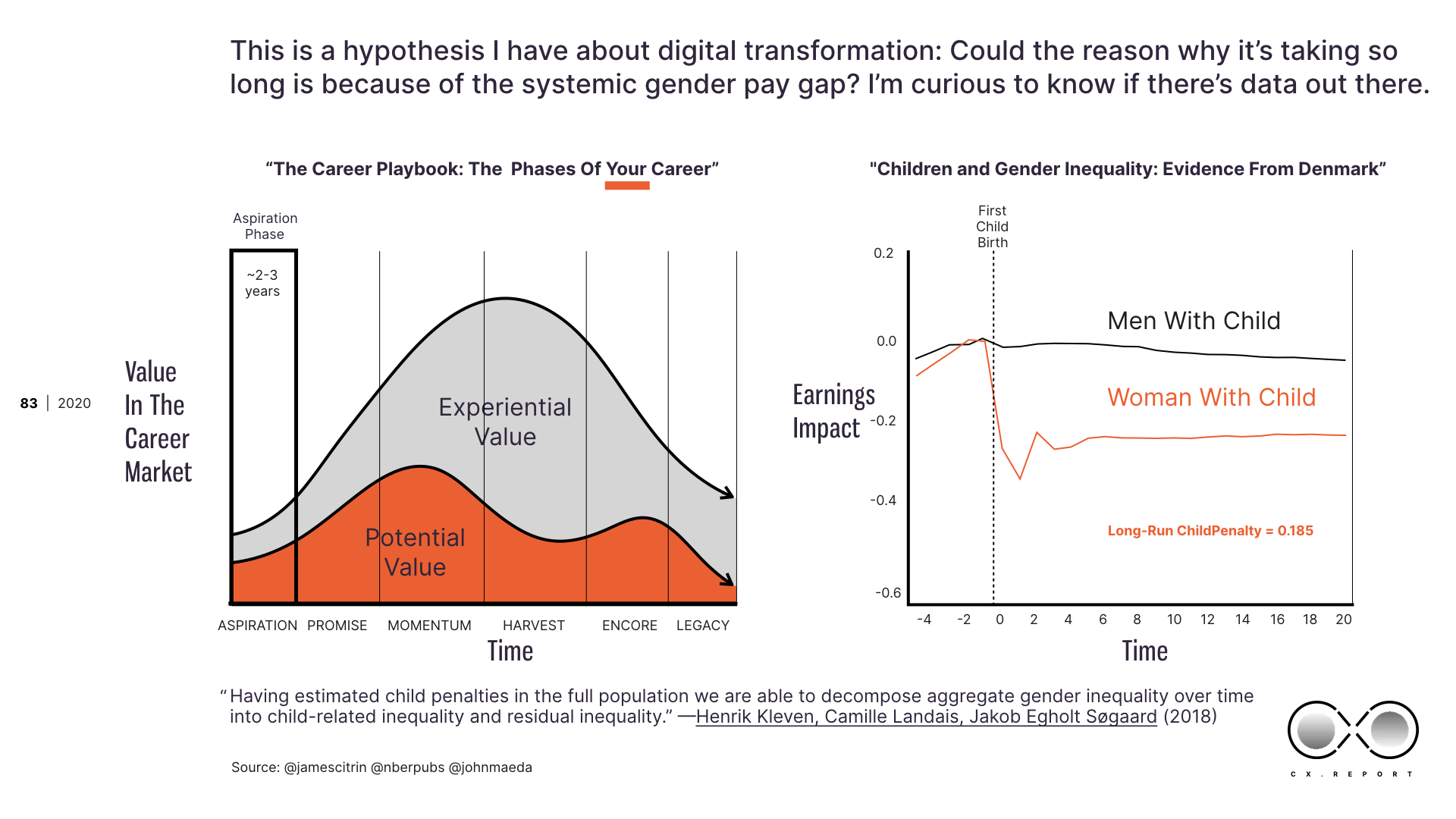
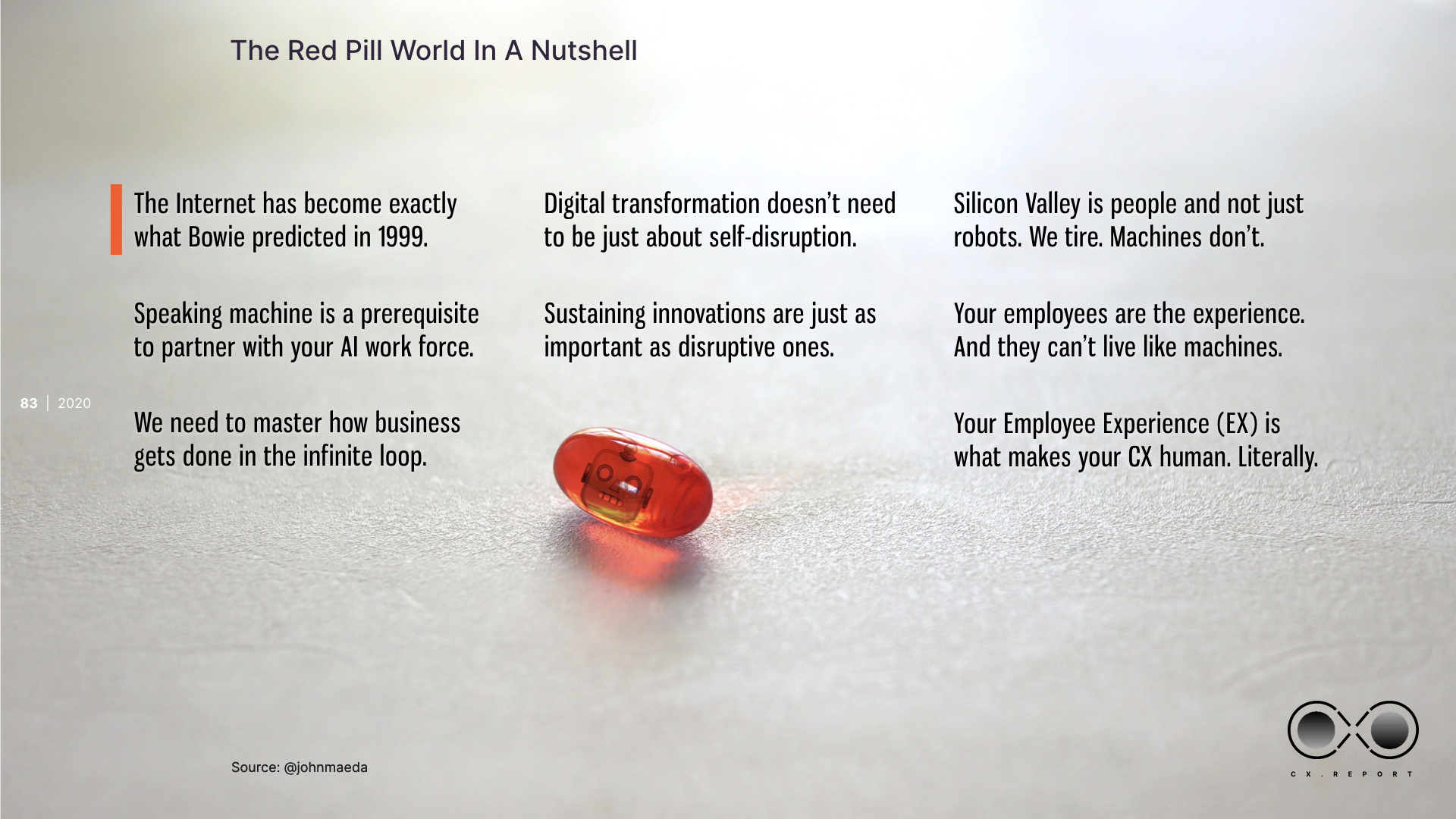
- The Internet has become exactly what Bowie predicted in 1999.
- Speaking machine is a prerequisite to partner with your AI work force.
- We need to master how business gets done in the infinite loop.
- Digital transformation doesn’t need to be just about self-disruption.
- Sustaining innovations are just as important as disruptive ones.
- Silicon Valley is people and not just robots. We tire. Machines don’t.
- Your employees are the experience. And they can’t live like machines.
- Your Employee Experience (EX) is what makes your CX human. Literally.


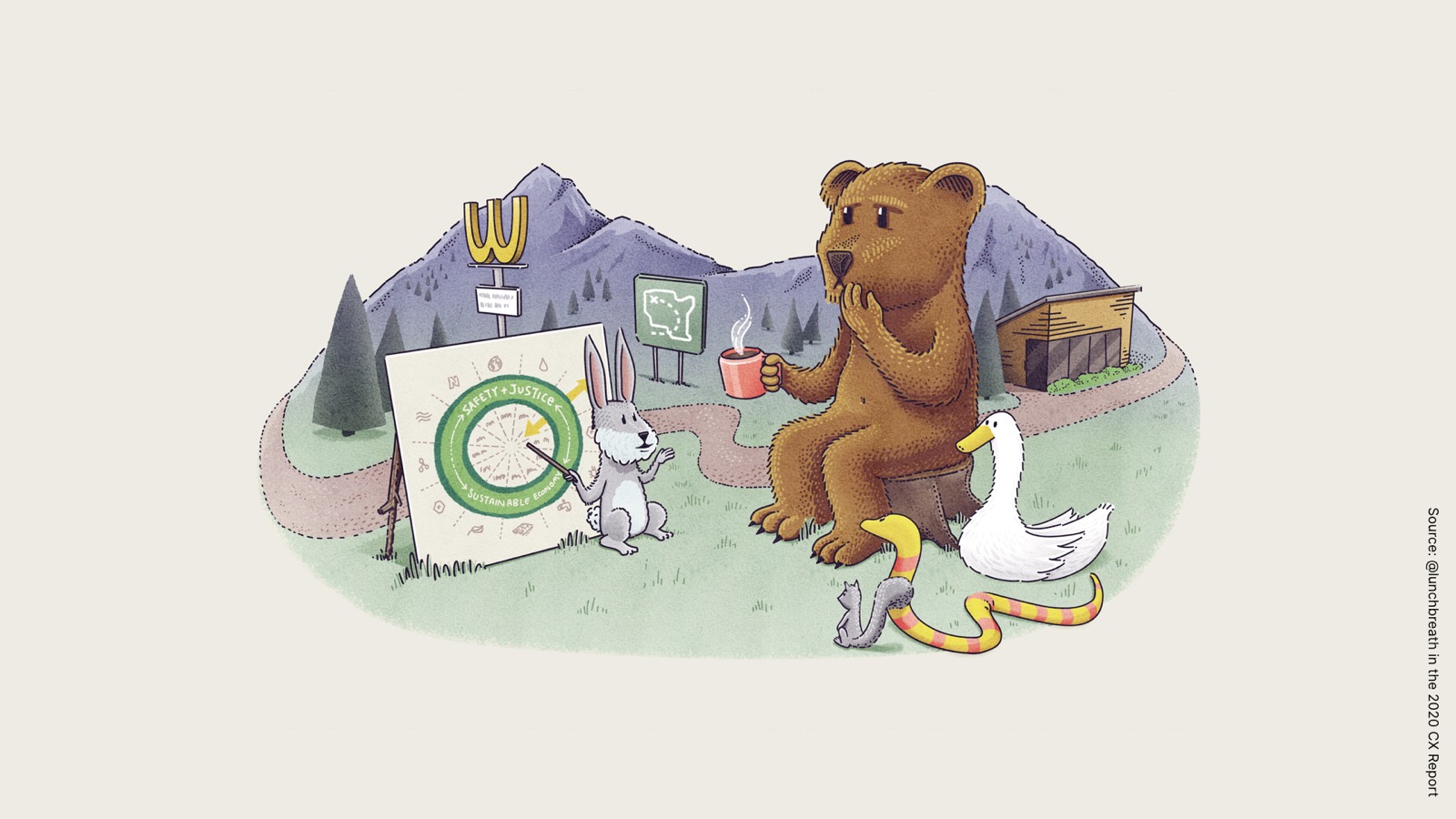
#cxreport20
Bonus Content
This video shows how easy it is for a CIO-centric view of the universe to miss Shared Customer Insights — well, at least metaphorically.
If you’re into raw data, I posted the 1000 points of view on who should really own customer experience over here. It’s quite delicious at times.
And ICYMI, the Distributed Work and Remote Work appendix to the CX Report went out in March 2020. Enjoy!
Book Recommendations

There’s a few books I recommend in the report directly, or implicitly. Here’s the list of books in the order that they appear in my video.
- How To Speak Machine [primer on computation]
- Laws of Simplicity [primer on design]
- Escaping the Build Trap [primer on product management]
- Competing Against Time [primer on logistics]
- Self-Renewal [primer on life — good medicine]
- The Longetivity Economy [primer on aging]
- Effortless Experience [primer on customer support]
- Designed for Digital [primer on digital transformation]
- Disability Series of the NYT [primer on disability]
- 6 Memos for the Next Millennium [primer no the future]
- Strategic Writing for UX [best modern primer on UX]
- So You Want To Talk About Race [primer on race]
- No Hard Feelings [primer on emotional leading]
- Guide To They/Them Pronouns [primer on the new]
- Computational Thinking [advanced take on computation]
- Hello World [primer on algorithms]
- How Brands Become Icons [deep book about what is brand]
CX Report Acknowledgements

Tony Ruth is designer and illustrator of the Equity series, the Six Trends series, and the 2020 “Sponsored By Earth” series. Quinnton Harris is photographer and art director for the cover of the CX Report. Sarah Gold is the force behind Society Centered design. The entire thousand-strong Experience team at Publicis Sapient and the changing nature of their professions tells me that a sea change is necessary in how we solve problems, and ask the right questions, for some of the biggest companies in the world. I thank my fellow Publicis Sapient colleagues for their fellowship and support: Wendy Johansson was instrumental in the CX Report Appendix on Distribute and Remote Work; Max Kirby is the Customer Data Platform expert that made me CDP-savvy; Karin Giefer has made me think a lot about how experience bridges strategy and engineering; Adam Morse and his new computational design approaches give me hope; Christian Waitzinger and Ian Wharton have made me think a lot about “brand.” I close with special thanks to the CEO of Publicis Sapient, Nigel Vaz, who has made me profoundly curious about the three words “digital business transformation” — and for the opportunity to teach more companies how to speak machine.

Briefing List
Sign up for my #ResilienceTech Briefing with no more than 2022 characters, zero images, and all in plain-text if you’re curious to learn more.
Suggested Email Newsletters
The Ethical Futures Lab has a terrific series of missives that always make me scratch my head a bit. [subscribe]
Benedict Evans always finds ways to connect so many dots in tech that makes you stand up and cheer for him. [subscribe]
Tina Roth Eisenberg (aka Swiss Miss) doesn’t have a newsletter but has a good old-fashioned RSS feed [subscribe]